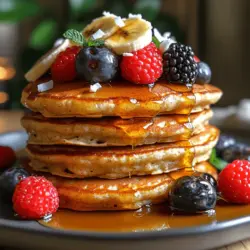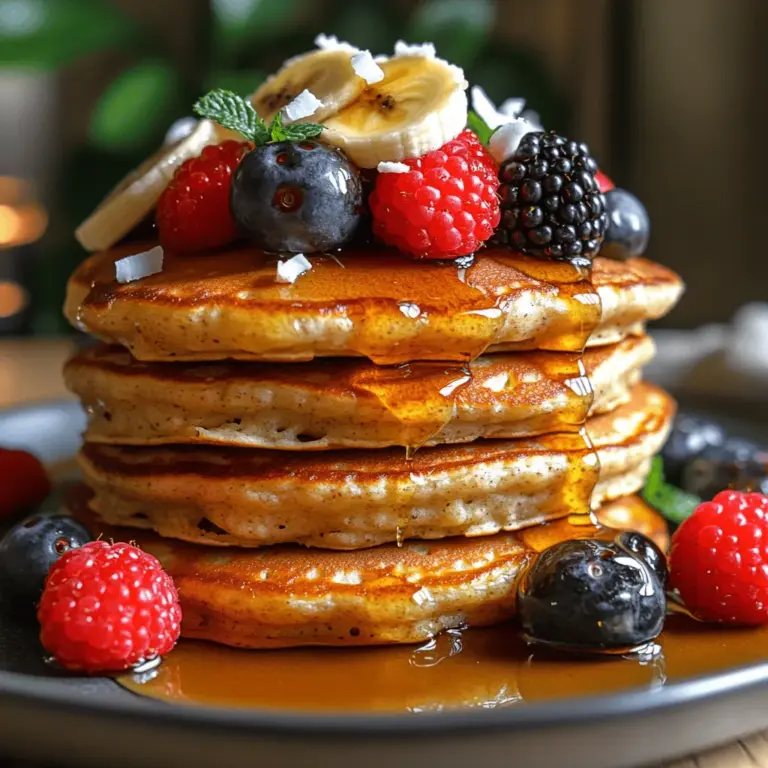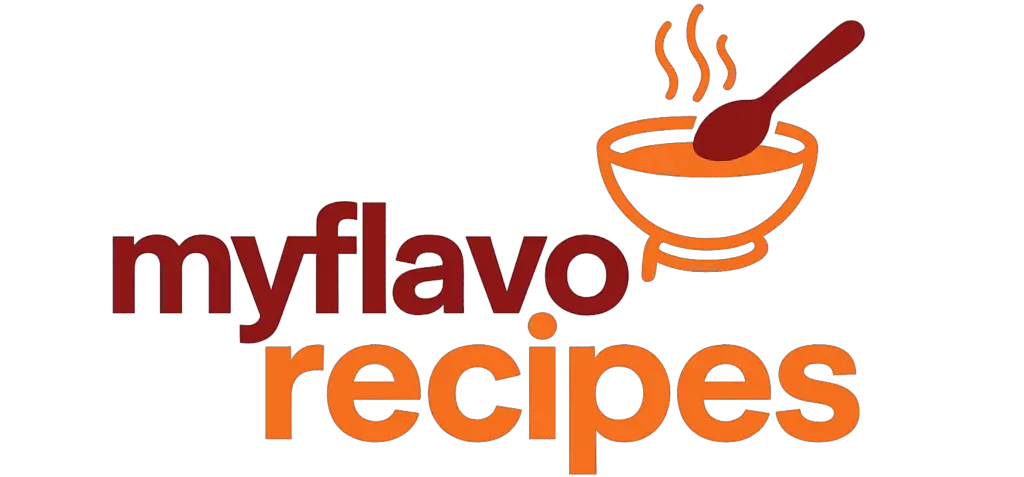In the realm of breakfast delights, pancakes hold a special place. These fluffy, golden stacks are not only versatile and easy to make but can also be adapted to suit various dietary preferences. Among the myriad of pancake variations, Coconut Bliss Pancakes stand out with their unique flavor profile and texture, thanks to the use of coconut flour and milk. This article will delve into the recipe for these delectable pancakes, providing step-by-step instructions, insights on the ingredients, and suggestions for customization. Whether you are looking to impress guests or simply enjoy a comforting breakfast at home, these pancakes are sure to satisfy.
Understanding the Ingredients
Before diving into the preparation of Coconut Bliss Pancakes, it’s essential to understand the key ingredients that make them so special. Each component contributes not only to the flavor but also to the nutritional profile of the pancakes.
Exploring Coconut Flour
Coconut flour is the star ingredient in this pancake recipe, and it deserves a closer look.
Nutritional Benefits of Coconut Flour
Coconut flour is not only gluten-free but also rich in dietary fiber, making it an excellent choice for those seeking healthier options. It contains healthy fats and is lower in carbohydrates compared to traditional flours, which can help maintain stable blood sugar levels. Moreover, coconut flour is a good source of protein, providing essential amino acids that can keep you feeling full and satisfied longer.
How Coconut Flour Differs from Wheat Flour
Unlike wheat flour, coconut flour absorbs a significant amount of liquid, which means you typically need to use less of it in your recipes. This high absorbency can lead to denser baked goods if not adjusted properly. It’s also worth noting that coconut flour has a naturally sweet flavor, reducing the need for additional sweeteners in your batter.
Tips for Storing Coconut Flour
To keep coconut flour fresh, store it in an airtight container in a cool, dark place. For longer shelf life, consider refrigerating or freezing it. Always check for any signs of spoilage, such as an off smell or discoloration, before use.
Examining the Role of Eggs
Eggs play a crucial role in pancake recipes, serving as a binder and providing structure to the batter.
Importance of Eggs in Pancake Recipes
The proteins in eggs coagulate during cooking, helping to give pancakes their fluffy texture. They also contribute to the overall richness and flavor of the pancakes, making them more satisfying.
Nutritional Value of Eggs
Eggs are a nutritional powerhouse, packed with high-quality protein, vitamins, and minerals. They are particularly high in B vitamins, which are essential for energy metabolism, and choline, which is important for brain health.
Alternatives for Egg-Free Versions
If you prefer or require an egg-free version, there are several substitutes you can use. Common alternatives include flaxseed meal mixed with water, applesauce, or mashed bananas. Each of these options can add moisture and binding ability to your pancakes, though they may slightly alter the texture and flavor.
The Importance of Coconut Milk
Coconut milk is another key component that enhances the flavor and texture of Coconut Bliss Pancakes.
Why Choose Full-Fat Coconut Milk
Full-fat coconut milk provides a rich, creamy consistency that makes the pancakes incredibly moist and flavorful. The fat content also helps prevent the pancakes from becoming too dry, ensuring they remain tender and delightful.
Health Benefits of Coconut Milk
Coconut milk is known for its medium-chain triglycerides (MCTs), which can provide quick energy and may support weight loss. It is also a source of vitamins C and E, which have antioxidant properties and can promote heart health.
Substitutions for Coconut Milk
If you don’t have coconut milk on hand, you can substitute it with almond, oat, or soy milk. However, for the best flavor and texture, sticking to coconut milk is recommended.
Sweetening the Deal: Honey and Maple Syrup
To enhance the flavor of these pancakes, we’ll incorporate natural sweeteners.
Natural Sweeteners vs. Refined Sugars
Using natural sweeteners like honey or maple syrup not only adds sweetness but also brings additional nutrients to the table. They are less processed than refined sugars, retaining some of their natural flavors and health benefits.
Adjusting Sweetness to Personal Preference
The amount of sweetener can be adjusted based on your personal taste. If you prefer a less sweet pancake, feel free to reduce the quantity of honey or maple syrup. On the flip side, if you enjoy a sweeter flavor, you can easily increase it.
Vegan Options for Sweeteners
For those following a vegan diet, maple syrup is an excellent choice. Additionally, agave nectar and date syrup are great alternatives that can provide the sweetness you desire without using animal products.
Coconut Oil: A Key Ingredient
Coconut oil is another essential ingredient in our Coconut Bliss Pancakes, contributing to their delightful flavor.
Health Benefits of Coconut Oil
Coconut oil is renowned for its health benefits, including its potential to improve heart health and support digestion. It contains MCTs, which may help with weight management and provide a quick source of energy.
Using Coconut Oil for Cooking Pancakes
When cooking your pancakes, using coconut oil helps prevent sticking and adds a subtle coconut flavor to the pancakes. You can use it for greasing your pan or griddle before cooking each batch.
Alternatives to Coconut Oil for Those with Allergies
If you’re allergic to coconut oil or simply prefer not to use it, you can substitute it with other oils, such as avocado oil or olive oil. Each oil will impart a slightly different flavor, so choose one that complements the overall taste you’re aiming for.
Step-by-Step Guide to Making Coconut Bliss Pancakes
Now that we have a solid understanding of the ingredients, let’s dive into the step-by-step process of making Coconut Bliss Pancakes.
Preparing the Batter
Creating the perfect pancake batter begins with combining the dry ingredients.
Detailed Instructions for Mixing Dry Ingredients
1. Sift the Coconut Flour: Start by sifting the coconut flour into a large mixing bowl. Sifting helps to aerate the flour, ensuring a lighter texture for your pancakes. It also removes any lumps that may have formed during storage.
2. Add Baking Powder and Salt: Once the flour is sifted, add baking powder to give your pancakes the lift they need to become fluffy. A pinch of salt will enhance the flavors and balance the sweetness.
3. Mix Well: Use a whisk to combine the dry ingredients thoroughly. This step is crucial as it ensures even distribution of the baking powder and salt, preventing any pockets of flavor that could disrupt the taste of your pancakes.
Incorporating Wet Ingredients
Next, you’ll want to incorporate the wet ingredients, which will transform your dry mixture into a batter.
Whisking Techniques for a Smooth Batter
1. In a Separate Bowl, Whisk the Eggs: Crack the eggs into a separate bowl and beat them lightly with a fork or whisk until the yolks and whites are fully combined. This will help to create a uniform batter.
2. Combine with Coconut Milk and Oil: Add the full-fat coconut milk and melted coconut oil to the beaten eggs. Whisk these ingredients together until they are fully blended. This step is essential for achieving a smooth consistency in your batter.
3. Combine Wet and Dry Ingredients: Gradually pour the wet mixture into the dry ingredients, stirring gently with a spatula or wooden spoon until just combined. Be careful not to overmix; it’s okay if there are a few lumps in the batter, as this will help keep your pancakes fluffy.
By following these steps, you’re well on your way to enjoying a delicious stack of Coconut Bliss Pancakes. Stay tuned for the next part of this article, where we’ll dive into the cooking process, tips for achieving the perfect pancake, and delightful serving suggestions.
{{image_1}}
Combining Wet and Dry Ingredients Efficiently
To achieve the perfect Coconut Bliss Pancakes, the first step is to combine the wet and dry ingredients effectively. Begin by preparing your dry mixture in a large bowl. This will typically include your flour, baking powder, sugar, and a pinch of salt. Whisk these ingredients together to ensure that the baking powder is evenly distributed throughout the flour, preventing any pockets of leavening agent that can lead to uneven rising.
Next, in a separate bowl, mix your wet ingredients. This should include coconut milk, melted coconut oil, and vanilla extract. Whisk these ingredients together until they are fully combined. The key here is to ensure that the melted coconut oil does not solidify – it should remain in a liquid state to mix easily with the other wet components.
Once both mixtures are prepared, create a well in the center of the dry ingredients and pour the wet mixture into it. Gently fold the two mixtures together using a spatula or wooden spoon. It’s important not to overmix; a few lumps are fine. Overmixing can lead to tough pancakes as the gluten in the flour develops too much. The goal is to combine just until the flour is moistened.
Resting the Batter
Why Resting is Crucial for Texture
Resting the pancake batter is a crucial step that many home cooks often overlook. Allowing the batter to sit for 10-15 minutes before cooking serves multiple purposes. First, it gives the flour time to hydrate fully, which contributes to a better texture. Second, during this resting period, the gluten will relax, resulting in lighter, fluffier pancakes. This means that when cooked, the pancakes will rise beautifully and have a tender bite rather than a dense or chewy consistency.
Expected Consistency of the Batter After Resting
After resting, your batter should have thickened slightly and be smooth with a few small lumps remaining. The consistency should be pourable but not too runny, resembling a thick cake batter. If the batter appears too thick, you can add a splash of coconut milk to achieve your desired consistency. Conversely, if it’s too thin, a tablespoon of flour can help thicken it up.
Cooking Techniques for Perfect Pancakes
Preheating the Skillet: Why It Matters
The cooking surface is just as important as the batter itself. Preheating your skillet is crucial for achieving that golden-brown crust on your pancakes. Heat a non-stick skillet or griddle over medium heat for about 5 minutes. To test if it’s ready, sprinkle a few drops of water on the surface; if they dance and evaporate quickly, your skillet is hot enough.
If you’re using a cast-iron skillet, make sure to adjust the heat as necessary; they retain heat well but can become too hot if left unattended. Lightly grease the skillet with coconut oil or non-stick cooking spray to prevent sticking, ensuring each pancake cooks evenly and releases smoothly.
Tips for Flipping Pancakes Without Breaking
Flipping pancakes can be a delicate affair, but with the right technique, it becomes easy. Wait until the edges of the pancake start to look set and bubbles form on the surface, indicating that they are ready to flip. Use a thin spatula and gently slide it underneath the pancake. With a quick, confident motion, flip it over to cook the other side. Avoid pressing down on the pancake after flipping, as this can hinder the rise and make them dense.
Cook for an additional 1-2 minutes until the pancake is golden brown and cooked through. Keep the finished pancakes warm in a low oven while you finish cooking the remaining batter.
Serving Suggestions
Ideas for Toppings: Fruits, Yogurt, Coconut Flakes
Once your Coconut Bliss Pancakes are perfectly cooked, it’s time to think about serving. The beauty of pancakes is in their versatility, especially when it comes to toppings. Fresh fruits such as sliced bananas, strawberries, or blueberries add a delightful burst of flavor and freshness. For a tropical touch, consider adding pineapple or mango slices.
A dollop of Greek yogurt can offer a creamy texture and a boost of protein. Sprinkle some toasted coconut flakes on top for an extra crunch and to enhance the coconut flavor. Drizzle with pure maple syrup or honey for sweetness, and you have a breakfast that’s as beautiful as it is delicious.
How to Create an Appealing Pancake Stack
For a visually appealing stack, layer your pancakes on a plate, slightly offsetting each layer to showcase the fluffy texture. Top with a pat of coconut butter or a sprinkle of coconut flakes and fresh fruits, making it Instagram-ready. A light dusting of powdered sugar can also add a lovely touch, bringing brightness to the presentation.
Nutritional Information
Caloric Breakdown of Coconut Bliss Pancakes
Understanding the nutritional profile of your Coconut Bliss Pancakes can help you appreciate their health benefits. Each serving, typically consisting of two pancakes, contains approximately 220-250 calories, depending on the specific ingredients used and the size of the pancakes. This caloric count is relatively moderate compared to traditional pancakes, which often range from 300-400 calories per serving, especially when made with refined flour and sugar.
Comparison with Traditional Pancake Recipes
In addition to being lower in calories, Coconut Bliss Pancakes offer a range of nutritional benefits that make them a healthier option. While traditional pancakes can be high in refined sugars and low in fiber, the use of whole ingredients like coconut flour introduces healthy fats and dietary fiber, making these pancakes more satiating and nutritious.
Health Benefits of Ingredients Used
Nutritional Advantages of Using Coconut Products
Coconut products are not just flavorful; they come with several health advantages. Coconut milk is rich in medium-chain triglycerides (MCTs), which can boost metabolism and provide a quick source of energy. Additionally, coconut flour is high in fiber, promoting digestive health and helping to maintain steady blood sugar levels.
Protein Content and Fiber Benefits from the Ingredients
Incorporating eggs or plant-based alternatives adds protein to the mix, making these pancakes a well-rounded breakfast option. The fiber content from both coconut flour and any fruits you choose to add can aid in digestion and provide a feeling of fullness, making them a satisfying meal to start your day.
Customization Options for Coconut Bliss Pancakes
Gluten-Free Alternatives
For those with gluten sensitivities, adapting this recipe is easy. Coconut flour is naturally gluten-free, but if you want to explore other options, almond flour or a gluten-free all-purpose flour blend can work well too. Just be sure to adjust the liquid content, as different flours absorb moisture differently.
Other Flour Options That Maintain the Fluffy Texture
If you’re looking for a more traditional pancake texture, you might consider a mix of coconut flour and almond flour, which complements the coconut flavor while still ensuring a fluffy result. Aim for a ratio of about 1:2 coconut flour to almond flour for the best results.
Vegan Modifications
For those following a vegan diet, replacing eggs with flaxseed meal or chia seeds can achieve similar binding results. Combine 1 tablespoon of flaxseed meal with 2.5 tablespoons of water, let it sit for a few minutes until it thickens, and then add it to your wet ingredients. This substitution will keep your pancakes fluffy and delicious without sacrificing taste.
Ensuring the Pancakes Remain Fluffy and Delicious
To ensure that the pancakes maintain their fluffiness when using plant-based alternatives, take care not to overmix the batter. The same principles apply whether using eggs or egg substitutes; gentle folding is key.
Adding Flavor Variations
To elevate your Coconut Bliss Pancakes even further, consider infusing the batter with warm spices like cinnamon or nutmeg. A teaspoon of vanilla extract can also enhance the overall flavor profile. If you want to indulge your sweet tooth, fold in chocolate chips or chopped nuts for added texture and flavor.
Conclusion: Enjoying Coconut Bliss Pancakes
Coconut Bliss Pancakes offer a delightful way to start your day with a nutritious and satisfying meal. With their unique coconut flavor and fluffy texture, they are not only a treat for your taste buds but also a healthy option for breakfast. By understanding the ingredients, following the detailed cooking instructions, and exploring customization options, anyone can create this delicious dish. Whether enjoyed on a leisurely weekend morning or as a quick weekday breakfast, these pancakes are sure to become a favorite in your household. Embrace the joy of cooking and savor the bliss that comes with each bite of these delightful pancakes.



